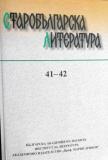„Болгарский напел/роспев“ в Украйна и на Балканите
Bulgarian Napel/Rаspev in Ukrain and on the Balkans
Author(s): Elena TončevaSubject(s): Cultural history
Published by: Институт за литература - БАН
Summary/Abstract: BULGARIAN NAPEL/RАSPEV IN UKRAIN AND ON THE BALKANS ELENA TONCHEVA (SOFIA) (Summary) In Ukrainian and Belarusian manuscripts from the end of the 16th and throughout the 17th and 18th centuries and in Russian manuscripts (starting from the 17th century) a large musical repertoire was notated using the Kievan quadratic staff notation and associated with the ethnonym “Bulgarian” (i.e. Bolgarsky Napel/Raspev – Bulgarian chant). Three Heirmologia from the 17th and 18th centuries with such repertoire are located it in the Great Skit Monastery (Eastern Carpathians) – a centre of this “Bulgarian singing”. After discovering the first Slavonic Balkan musical records with late Byzantine notation dating from the 15th and 16th centuries (after a long period of oral tradition) the idea was formed to conduct a comparative research between chants with parallel texts (in Greek and Slavonic) notated whit the two notations – late Byzantine and Kievan staff notation. On the basis of such parallel transcription close resemblances between the melodies were presented. These results suggested that Balkan musical notated sources for the Ukrainian Bolgarskij napel were discovered. The question posed in this study is how the two practices of Bulgarian chant – on the Balkans and in Ukraine – are informative in terms of modal (echos) characteristics. The conclusions, based on comparative study of two versions of the automelon ‘Oi anggelikai…” in the 6th (2 th plagal) mode (from the Skit Heirmologia and from the late Byzantine bilingual MS Athens 928 – Žegligovo anthology from the 15th century) are the following: 1. In the Ukrainian “Bulgarian” singing repertoire various modal (psalmodic) melodic patterns, characteristic of the Balkans, have been known and used, and 2. the modal characteristic of the Balkan Slavonic singing in the 6th mode is diatonic – not chromatic – as it is in later modal Byzantine systematizations.
Journal: Старобългарска литература
- Issue Year: 2009
- Issue No: 41-42
- Page Range: 427-440
- Page Count: 14
- Language: Bulgarian
- Content File-PDF

